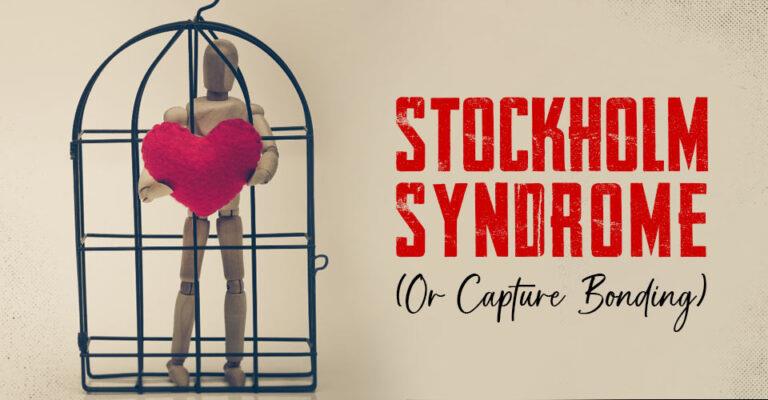You’ve probably heard the term Stockholm syndrome before. It’s that weird idea where someone who’s been kidnapped starts feeling emotionally attached to the person holding them hostage. Sounds bizarre, right? Like, why would anyone feel close to someone who’s threatening their life?
It almost seems like something made up by Hollywood. But here’s the thing — people are still debating if it’s real or not. So in this piece, let’s hear from the experts and also from people who’ve lived through it.
Table of Contents
ToggleWhat Even Is Stockholm Syndrome?

Alright, so in simple terms, Stockholm syndrome happens when someone who’s been held against their will starts feeling trust, loyalty, or even affection toward their captor. Yeah, it’s wild. Flips your expectations. You’d think the victim would hate the captor. But no, sometimes the brain does something unexpected.
The name comes from a real event — a bank robbery in Stockholm, Sweden, back in 1973. Hostages were held for six days, and after they were released, they defended their captors. Weird, right? Psychologists started paying attention, and many believe it’s the mind’s way of trying to survive something terrifying.
Why Would That Happen?

Okay, so here’s the deal — when someone’s in danger and they can’t fight back or escape, the brain goes into “survive no matter what” mode. If you can’t fight or flee, sometimes the next best option is to attach emotionally. It’s not love — it’s like an emotional shield.
The person might start seeing their captor as “not that bad,” especially if they show small acts of kindness. It’s not about romance. It’s just the brain doing whatever it can to make the situation feel less terrifying.
Real-Life Cases Where This Happened
| Year | Case | What Happened | Notes |
| 1973 | Norrmalmstorg Robbery | Hostages sided with their captors | Origin of the term |
| 1974 | Patricia Hearst | Joined the group that kidnapped her | Still debated if it was survival or belief |
| 1996 | Jaycee Dugard | Kidnapped for 18 years, bonded emotionally | Deeply complex emotional aftermath |
| 2005 | Elizabeth Smart | Felt empathy, but remained defiant | A mix of emotional responses |
Each of these cases played out differently. Some victims formed deep emotional bonds, while others didn’t. It depends on the situation, and more importantly, the person.
What Do Psychologists Think?
Not all psychologists are on the same page about Stockholm syndrome. It’s not officially listed in diagnostic manuals like the DSM-5. Still, lots of trauma experts recognize it as a real coping mechanism.
As Dr. Rachel Thompson puts it:
“It’s not love. It’s survival. When you’re terrified, your brain adapts however it can.”
Makes sense. It’s less about affection and more about staying emotionally afloat in a terrifying situation.
Stockholm Syndrome vs. Trauma Bonding
People mix these two up all the time. They sound kinda similar, but they’re different.
| Term | What It Means | When It Happens | How Long Does It Last |
| Stockholm Syndrome | An emotional bond is formed under direct threat | Kidnapping, hostage, and captivity scenarios | Short to medium-term |
| Trauma Bonding | Ties formed from repeated abuse cycles | Long-term toxic or abusive relationships | Often lasts years or decades |
So yeah, knowing the difference matters. Trauma bonding usually involves people who stay in abusive relationships. Stockholm syndrome usually starts when someone’s not free to leave.
Hearing From Survivors Themselves

Let’s be real — listening to actual survivors tells you way more than any textbook. Jaycee Dugard, who was held captive for 18 years, said she felt everything from fear to a kind of dependence. Elizabeth Smart also mentioned feeling conflicted — sometimes understanding her captor’s emotions, but never forgetting the horror.
These stories aren’t neat or simple. They’re messy, emotional, and very, very real. Healing for them takes years.
Why It’s So Hard to Diagnose
| Problem | Why It’s Hard | How It Affects Help |
| No Official Diagnosis | Not in the DSM or ICD | Makes treatment plans unclear |
| Wildly Different Cases | Every victim reacts differently | Therapy needs to be super personalized |
| Overlaps with PTSD | Looks like anxiety, trauma, etc. | Misdiagnosis is common |
| Public Confusion | People don’t get it or blame the victim | Makes support harder to give and receive support |
Public Misunderstanding and the Media Mess

Movies and TV shows have kind of ruined how we talk about this. They often make it look like a twisted love story. But that’s not the reality for survivors. When we romanticize this stuff, we hurt the people who lived through it. We’ve got to get better at understanding trauma for what it is.
What Do Experts Think?
Most mental health professionals agree that yes, Stockholm syndrome is real. But it’s not about love. It’s survival. Dr. James Carter nails it:
“It’s how the brain copes when there’s no way out.”
Some experts think we throw the term around too casually, especially in pop culture. But the emotional response is valid. It’s a brain trying to stay alive.
How Do You Heal From It?

There’s no quick fix. Healing takes time, care, and a whole lot of support. Therapies like CBT (Cognitive Behavioral Therapy) and trauma-informed care can help survivors process what happened and start rebuilding their lives.
Survivors say that being believed, being heard, and being treated with patience is what really makes a difference. It’s not a straight line, but healing is absolutely possible.
If you or someone you care about is dealing with trauma or complicated emotions after abuse or captivity, please reach out. You don’t have to go through it alone. Support is out there — and recovery is possible, even if it’s slow.
Final Thoughts
So… is Stockholm syndrome real? Yeah. But it’s not what most people think. It’s not about love, loyalty, or weakness — it’s about survival. The brain is just doing what it has to do to make it through. For some, it fades fast. For others, it lingers. Either way, it’s something we should take seriously, not dismiss or romanticize. The more we understand it, the better we can support those who’ve been through unthinkable situations.
FAQs
Is Stockholm syndrome officially recognized as a mental illness?
Nope. It’s not in major diagnostic manuals, but therapists still use the term to talk about real trauma reactions.
Does everyone who’s kidnapped develop it?
Not at all. It depends on a bunch of things — the person, the situation, how long they were held, etc.
How long does it usually last?
It varies. Some people move on pretty fast, others carry it with them for years. There’s no fixed timeline.
Is the victim at fault for having these feelings?
Not. It’s not a choice. It’s just how the brain responds under intense stress.
Can Stockholm syndrome affect how courts see a victim’s case?
Yeah, it can. It sometimes leads to people doubting the victim or not taking them seriously, which is unfair.
What helps someone recover from Stockholm syndrome?
Therapies focused on trauma (like CBT) and support groups are helpful. But the main thing is — patience and support.
Has the media made Stockholm syndrome look worse than it is?
Kind of. Movies and shows often romanticize it, which makes it harder for people to understand what it is — trauma, not romance.





